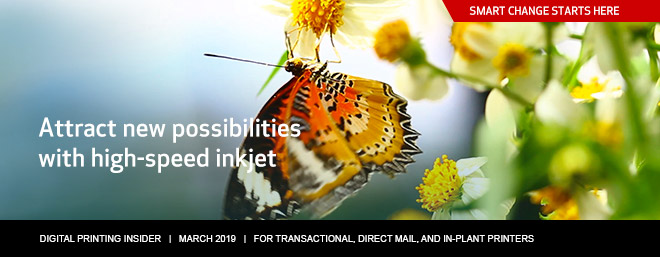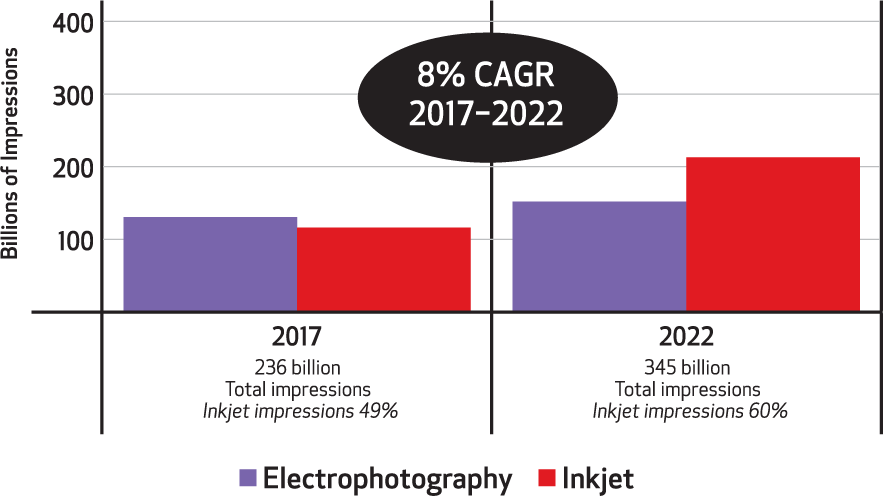Bring Value to Direct Mail, Bills, and Statements with Inkjet
In a print industry challenged by mobile communications, inkjet represents a bright spot. Because it provides excellent Total Cost of Operation (TCO), it comes as no surprise that inkjet is expected to show continued growth. According to Keypoint Intelligence—InfoTrends’ research, inkjet will represent about 60 percent of digital production color volumes by 2022. Some of that growth can be attributed to migration from traditional offset and established toner-based printing, but there are also a number of new print applications thanks to the speed, quality, and cost advantages of high-speed inkjet devices.
Digital Print Volume Continues to Grow
Sources: U.S. Print on Demand Market Forecast: 2017–2022, InfoTrends, 2018.
According to two recent surveys from InfoTrends (Applications in Digital Print Survey 2018 and High-Speed Inkjet Printing in Commercial Print Markets), the most popular color digital print applications include direct mail, bills, and statements. In addition to these applications, InfoTrends found that service providers are using inkjet technology to produce a wide range of brochures, “magalogs” (catalogs that include article content), catalogs, books, magazines, newspapers, and packaging.
Why is inkjet such a lucrative technology for these applications? While volume requirements and final specifications play a role, the primary allure of high-speed inkjet production is cost. Provided that costs can be controlled, there is an opportunity to maintain—and sometimes increase—profit margins on current products while also expanding into new areas. Inkjet takes the power of digital printing, which is perfect for bringing personalization and embellishments to a wide variety of print applications, and makes it faster and even more affordable!
…there is an opportunity to maintain—and sometimes increase—profit margins…
Because traditional offset technology cannot usually produce personalized marketing and TransPromo applications cost-effectively, the opportunity to expand in digital printing products is something that every printer should investigate. Digital printing capabilities are expanding all the time, bringing improvements to speed, print quality, and substrate options. When asked about the share of applications that generally incorporated personalization or TransPromo techniques, respondents to InfoTrends’ survey said direct mail accounted for the highest share (65 percent).
Direct mail—including postcards, brochures, and other types of marketing collateral—forms the backbone of most campaigns, and is often paired with online, mobile, or mass media delivery. For printed communications, inkjet provides a cost-effective solution that is available across a growing number of substrates. Today’s inkjet devices can produce vibrant hues, faithfully reproduce brand colors, and support photographic images. In addition, digital technology means that campaigns can be highly targeted, even if they are not personalized.
Accuracy, security, and integrity are essential attributes for transactional documents. As a result, bills, statements, and TransPromo communications must print in a manner that leaves a verifiable audit trail. Although some smaller companies might still overprint on offset shells, most companies recognize the efficiency of print solutions that begin with white paper and end with the creation of a full-color communication that includes all elements (e.g., variable data) in the final print job. Thanks to digital technology, the designs can use color, tint boxes, and graphics to make it easier to interpret and react to the information.
With the advent of high-speed inkjet technology, printing onto static shells is limiting and inefficient. White paper factory solutions merge the form design and data and sometimes use data to trigger specific graphic elements for printing in a continuous stream. “Statement-based marketing,” better known as TransPromo, involves placing promotional, educational, and informational messaging alongside transactional data. It has emerged as a solution that takes advantage of high-speed inkjet technology while also producing a higher level of customer engagement. Unlike a direct mail piece, a TransPromo document always contains some transactional or regulatory content.
Some firms are able to use the excess white space on their documents to generate revenue while others use it to link to existing direct marketing campaigns or replace inserts. The costs of full-color printing decrease all the time, so more marketers and customer communications professionals are attracted to the possibilities of transactional documents—and color adds another important design element to the mix. With increased requirements for reproduction quality of transactional documents, TransPromo extends the application category for high-speed full-color inkjet printers.
The core value of production inkjet technology is that it enables print applications that other technologies cannot produce, such as affordable high-value personalization, shorter runs, and versioning. High-speed inkjet systems are producing high volumes for transaction and direct mail not because they are cheaper than offset, but because they can do something that offset cannot do. High-speed inkjet is delivering value to marketers, enterprises, and service providers. It offers affordable digital color and associated improvements in operational costs, response rates, and time-to-market. Organizations that have not yet explored the inkjet opportunity need to act now if they hope to enjoy all its benefits!
Interested in learning more? Check out InfoTrends’ written report or white paper entitled “Inkjet Applications Matter! Opportunities & Trends in Production Inkjet” to see the breakdown of inkjet suitability as well as more data about the inkjet market today.
WATCH THE VIDEO


